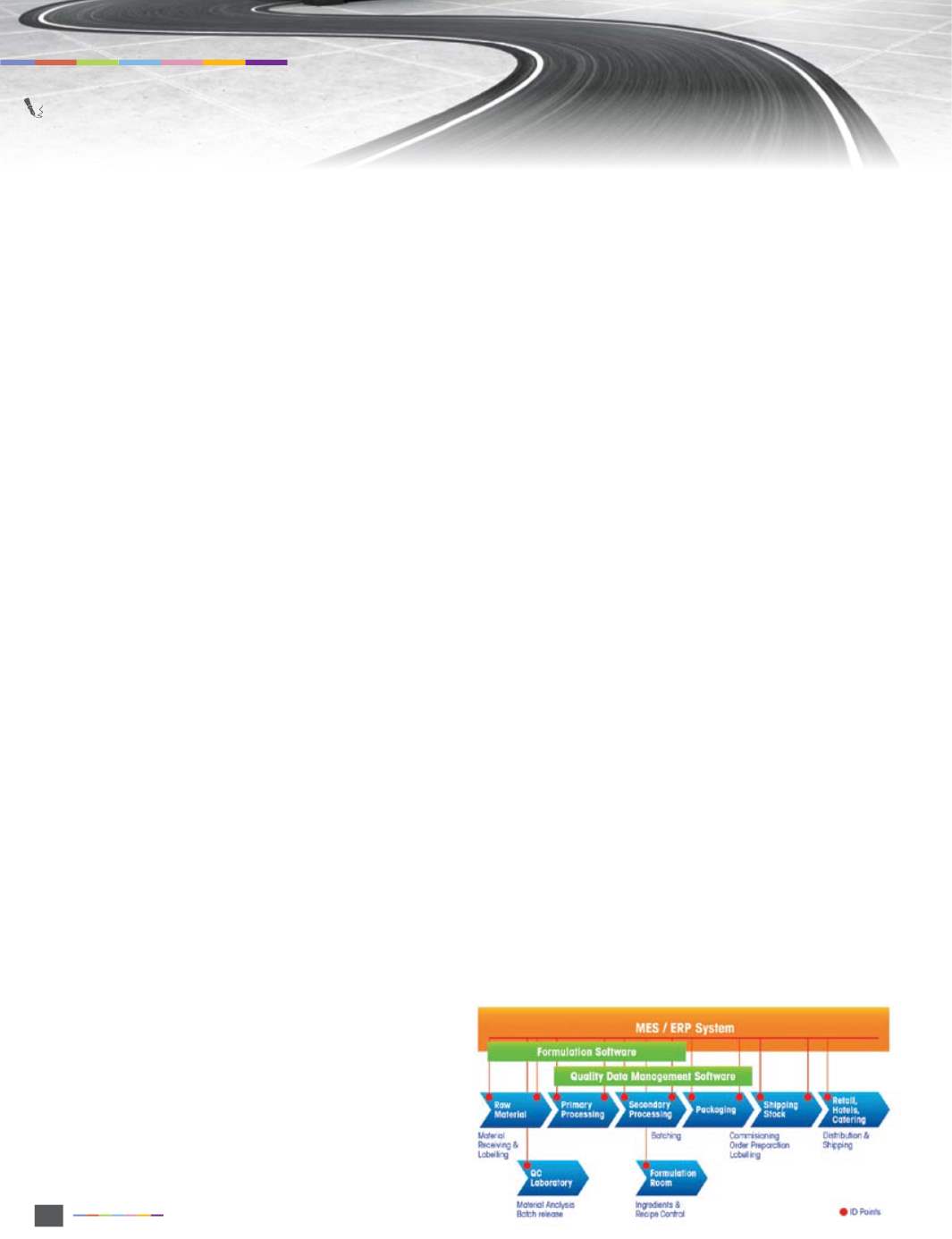
Food Focus Thailand
APRIL 2014
54
STORAGE,
HANDLING & LOGISTICS
กระบวนการตรวจสอบย้
อนกลั
บได้
ถู
กกำหนดให้
เป็
นความสามารถ
ในการติ
ดตามวั
ตถุ
ดิ
บและส่
วนประกอบที่
ใช้
ในการผลิ
ตที่
จะใส่
ลงไป
ในผลิ
ตภั
ณฑ์
ผ่
านทุ
กขั้
นตอนของการรั
บวั
ตถุ
ดิ
บ การผลิ
ต การแปรรู
ป
และการกระจายสิ
นค้
า
Traceability is defined as “the ability to follow raw
materials and components intended to be, or
expected to be, incorporated into a product, through
all stages of receipt, production, processing and
distribution.”
การตรวจสอบย้
อนกลั
บเพื่
อความปลอดภั
ย
้
อ ั
บ ื่
อ
ั
ย
ของผู้
บริ
โภคและการพั
ฒนากระบวนการ
Traceability for Consumer Safety and Process Improvement
A
n ideal traceability system that fits into a company’s normal
work practice and enables quick and easy collection of relevant
information should consider some general principles when
designing or challenging an existing traceability system include,
making sure that it:
• Covers all stages of production, processing and distribution
• Identifies raw materials suppliers
• Identifies which components have been used in which
product
• Identifies supplied customers
• Identifies which products and intermediates have been disposed
of (verification of destruction may be required)
• Ensures products supplied to customers are adequately labeled
or identified to facilitate traceability and
• Provides details to authorities on-demand in a timely manner.
Unique identity codes such as delivery date, production or run
time, batch size, and expiry date should be used. This may consist
of an internal system for assigning a sequential number, or use the
supplier’s batch code or GTIN (Global Trade Identification Number).
Codes should include enough detail to ensure traceability back to the
production batch.
The traceability system must allow actions such as isolation of an
unsafe batch or recall from a depot to be taken within an appropriate
time frame. This time frame will relate to product characteristics
such as shelf life, production process/supply chain complexity, and
consumer risk.
A traceability system can be used to confirm that safety and quality
checks have been performed and sufficient records have been retained
for verification. This is particularly significant when investigating
customer complaints and legal compliance. Any test results, such as
microbiological testing, must also link back to original batches.
Agrowing number of consumer products must be supported by an
electronic file containing documentation that demonstrates the product
meets safety standards. This file becomes part of the traceability
system. It is good practice to use technical files even when it is not a
specific legal requirement.
Meaningful documentation provides evidence of production
history such as:
Incoming goods records and raw material quality
checks, Intermediate component records or mix recipes, Warehousing
and storage records, Delivery orders to the final customer, Records
of any subcontracted work.
Legislation dictates traceability record retention timeframes related
to product characteristics. For example, foods with a shelf life of less
than three months would need to be kept at least six months.
ร
ะบบที่
เหมาะสมกั
บการปฏิ
บั
ติ
งานตามปกติ
ของบริ
ษั
ท จะช่
วยให้
สามารถเก็
บ
ข้
อมู
ลที่
เกี่
ยวข้
องได้
ง่
ายและรวดเร็
ว หลั
กการทั่
วไปที่
จะต้
องพิ
จารณาเมื่
อ
ออกแบบระบบการตรวจสอบย้
อนกลั
บ ประกอบไปด้
วย
• ครอบคลุ
มทุ
กขั้
นตอนของการผลิ
ตการแปรรู
ปและการจั
ดจำหน่
าย
• ระบุ
ผู้
ผลิ
ตวั
ตถุ
ดิ
บ
• ระบุ
ส่
วนประกอบที่
จะนำมาใช้
ในผลิ
ตภั
ณฑ์
• ระบุ
ข้
อมู
ลลู
กค้
า
• ระบุ
ว่
าผลิ
ตภั
ณฑ์
และส่
วนผสมได้
รั
บการกำจั
ด (การตรวจสอบของการทำลาย
อาจจะจำเป็
นต้
องระบุ
)
• ต้
องมั่
นใจได้
ว่
าผลิ
ตภั
ณฑ์
ที่
จำหน่
ายให้
กั
บลู
กค้
ามี
ฉลากบ่
งชี้
ข้
อมู
ลเพี
ยงพอหรื
อ
ระบุ
เพื่
ออำนวยความสะดวกในการตรวจสอบย้
อนกลั
บ
• สามารถให้
รายละเอี
ยดกั
บเจ้
าหน้
าที่
เมื่
อถู
กเรี
ยกดู
ข้
อมู
ลในเวลาที่
ถู
กต้
องเหมาะสม
รหั
สที่
มี
ความเฉพาะเจาะจง เช่
น วั
นที่
การส่
งผลิ
ตภั
ณฑ์
เวลาทำงาน จำนวนของ
ผลิ
ตภั
ณฑ์
และวั
นหมดอายุ
ควรถู
กนำมาใช้
ซึ่
งข้
อมู
ลเหล่
านี้
อาจประกอบด้
วยข้
อมู
ล
ภายในสำหรั
บการกำหนดลำดั
บหมายเลขหรื
อใช้
รหั
สชุ
ดของซั
พพลายเออร์
หรื
อ GTIN
(GlobaI Trade Identification Number) รหั
สควรมี
รายละเอี
ยดเพี
ยงพอที่
จะให้
ตรวจสอบย้
อนกลั
บ
ระบบตรวจสอบย้
อนกลั
บต้
องยอมให้
การดำเนิ
นการต่
างๆ เช่
น การแยกชุ
ดที่
ไม่
ปลอดภั
ย หรื
อการเรี
ยกคื
นผลิ
ตภั
ณฑ์
จากร้
านค้
า จะต้
องดำเนิ
นการภายในกรอบเวลา
ที่
เหมาะสม กรอบเวลานี้
จะเกี่
ยวข้
องกั
บลั
กษณะของผลิ
ตภั
ณฑ์
เช่
น อายุ
การเก็
บรั
กษา
กระบวนการผลิ
ต/ความซั
บซ้
อนของห่
วงโซ่
อุ
ปทาน และความเสี่
ยงของผู้
บริ
โภค
ระบบตรวจสอบย้
อนกลั
บสามารถใช้
ในการยื
นยั
นว่
า ความปลอดภั
ยและการตรวจสอบ
คุ
ณภาพที่
ได้
รั
บการดำเนิ
นการ ได้
ถู
กบั
นทึ
กและจั
ดเก็
บรั
กษาไว้
สำหรั
บการตรวจสอบ
อย่
างเพี
ยงพอ ซึ่
งเป็
นสิ่
งสำคั
ญโดยเฉพาะอย่
างยิ่
งเมื่
อมี
การตรวจสอบข้
อร้
องเรี
ยน
ที่
มาจากลู
กค้
า และการปฏิ
บั
ติ
ตามกฎหมายใดๆ ที่
เกี่
ยวข้
อง นอกจากนี้
ผลการทดสอบ เช่
น
การทดสอบทางจุ
ลชี
ววิ
ทยา ก็
ต้
องเชื่
อมโยงกลั
บไปยั
งกระบวนการผลิ
ตตั้
งแต่
ต้
นทางได้
ตั
วเลขการเติ
บโตของผลิ
ตภั
ณฑ์
ที่
ผู้
บริ
โภคจะต้
องได้
รั
บการสนั
บสนุ
นโดยไฟล์
อิ
เล็
กทรอนิ
กส์
ที่
มี
เอกสารประกอบที่
แสดงให้
เห็
นถึ
งผลิ
ตภั
ณฑ์
ที่
เป็
นไปตามมาตรฐาน
ความปลอดภั
ย ไฟล์
นี้
จะกลายเป็
นส่
วนหนึ่
งของระบบตรวจสอบย้
อนกลั
บ ซึ่
งเป็
น
เรื่
องที่
ดี
ที่
จะใช้
ไฟล์
ที่
มี
ข้
อมู
ลทางเทคนิ
ค ถึ
งแม้
จะไม่
ได้
เป็
นข้
อกำหนดทางกฎหมาย
ที่
เฉพาะเจาะจง
เอกสารที่
มี
ความหมายเพื่
อใช้
เป็
นหลั
กฐานของกระบวนการผลิ
ต เช่
น
บั
นทึ
ก
สิ
นค้
าขาเข้
าและการตรวจสอบคุ
ณภาพวั
ตถุ
ดิ
บ บั
นทึ
กองค์
ประกอบของส่
วนผสมหรื
อ
การผสมสู
ตร บั
นทึ
กการจั
ดเก็
บข้
อมู
ลคลั
งสิ
นค้
า การจั
ดส่
งสิ
นค้
าให้
กั
บลู
กค้
าปลายทาง
ประวั
ติ
ของการทำงานของผู้
รั
บเหมาช่
วง
บริ
ษั
ท เมทเล่
อร์
-โทเลโด (ประเทศไทย) จำกั
ด
Mettler-Toledo (Thailand) Limited
Figure 1
A Traceability System
รู
ปที่
1 /


